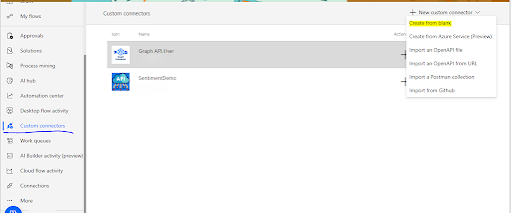Part 2: Building Power Apps Code Apps – Adding Office 365 Users Connection
Please refer to the following blog for a step-by-step guide on creating Code Apps : https://mspowerplatformtips.blogspot.com/2025/08/creating-code-apps-in-power-apps-step.html
Create and set up connections in Maker Portal
You will need to start by creating and configuring connections at https://make.powerapps.com and you’ll need to copy connection metadata from there for use in later steps.
Go to https://make.powerapps.com and navigate to the Connections page from the left-hand navigation.
Click “+ New connection” and select Office 365 Users. Click “Create”.
Then open the connection in Url you can see connection ID
Get connection metadata for all created connections
You can use the Power Apps CLI to list your available connections and retrieve their IDs:
pac connection list
This command will display a table of all your connections, including the Connection ID and API Name (which is used as the appId when adding a data source).
3. Add a connection to a code app
Once you have created or identified existing connections to use and copied the connection metadata from the previous step, you will now add those connections to the app. Adding the data sources to the app will automatically generate a strongly typed Typescript model and service file in the repo. For example, the Office 365 Users data source will produce Office365UsersModel and Office365UsersService.
1. Add a non-tabular data source (e.g. Office 365 Users) to the app From a command line, run the following. Use the API name and connection ID collected from Step #2 above.
pac code add-data-source -a <apiName> -c <connectionId>
Example pac code add-data-source -a "shared_office365users" -c "aa35d97110f747a49205461cbfcf8558"
Then Create the ProfileScreen.tsx file in src
add below code
import React, { useEffect, useState } from 'react';
import { Office365UsersService } from '../src/Services/Office365UsersService';
const ProfileScreen: React.FC = () => {
const [profile, setProfile] = useState<{ name: string; email: string; photo: string | null }>({
name: '',
email: '',
photo: null,
});
const [loading, setLoading] = useState(true);
useEffect(() => {
const fetchProfile = async () => {
try {
const profileResponse = await Office365UsersService.MyProfile();
const photoResponse = await Office365UsersService.UserPhoto(profileResponse.data.Id);
setProfile({
name: profileResponse.data.DisplayName,
email: profileResponse.data.Mail,
photo: photoResponse.data,
});
console.log('Profile data:', profileResponse.data);
console.log('Photo data:', photoResponse.data);
} catch (error) {
console.error('Error fetching profile:', error);
} finally {
setLoading(false);
}
};
fetchProfile();
}, []);
if (loading) {
return <div>Loading...</div>;
}
return (
<div style={{ textAlign: 'center', padding: '20px' }}>
{profile.photo && <img src={`data:image/jpeg;base64,${profile.photo}`} alt="Profile" style={{ borderRadius: '50%', width: '150px', height: '150px' }} />}
<h1>{profile.name}</h1>
<p>{profile.email}</p>
</div>
);
};
export default ProfileScreen;
in App.tsx
//import { useState } from 'react'
import './App.css'
import ProfileScreen from './ProfileScreen'
function App() {
return (
<>
<ProfileScreen/>
</>
)
}
export default App
now npm run build
if build successful then
npm run dev.
you will get URL









Comments
Post a Comment